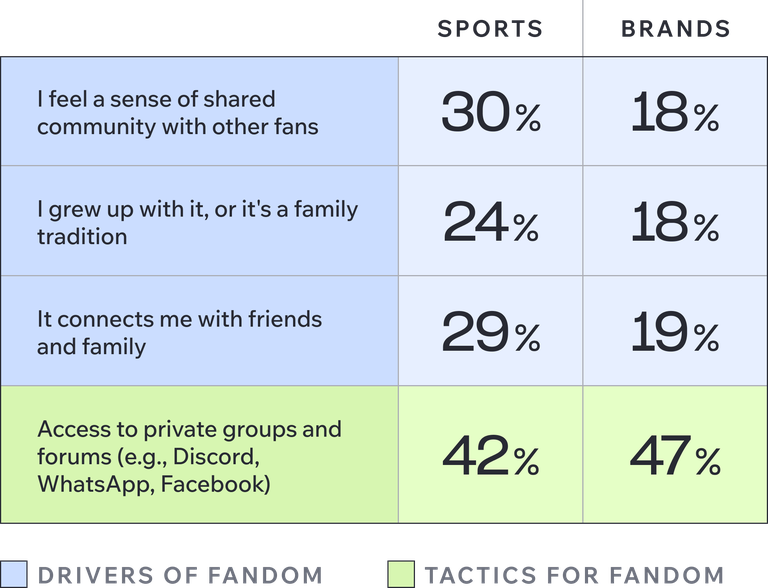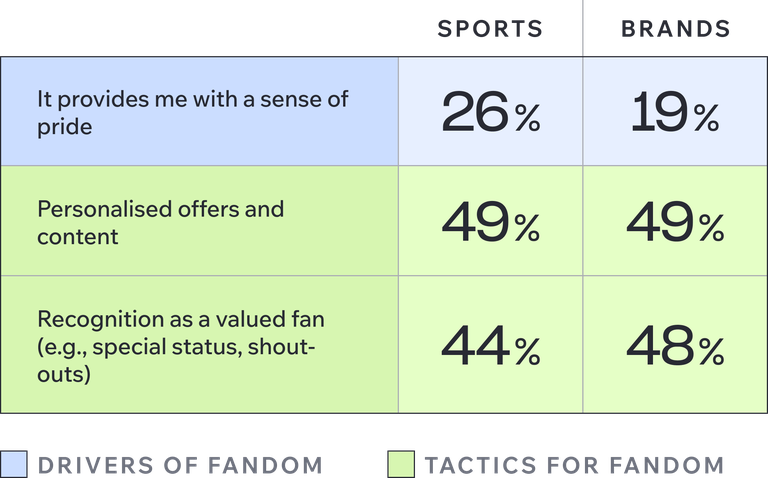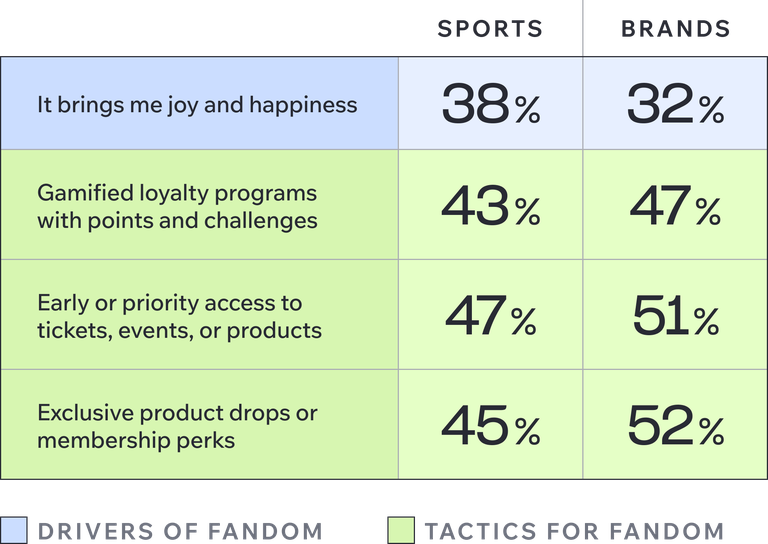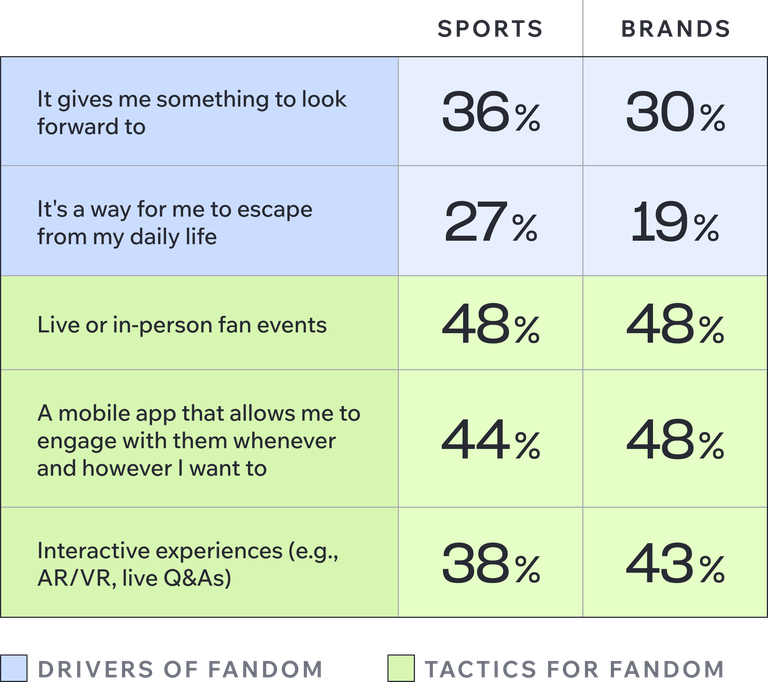Chapter 4
The Sports Playbook

There is no single tactic to make fandom magically happen. However, our research and experience working with sports teams and organisations reveals six plays that consumer brands can leverage across a digital ecosystem simultaneously to ensure they earn fandom in every interaction.
For each of these plays we've looked at the key fandom drivers (What are the reasons you are a fan of your favourite sports team or brand?) and tactics (What should your favourite consumer brand do more of to increase your sense of fandom?) to better understand how brands can foster fandom.
1. Enable Close Encounters
If we look at the drivers of sports fandom, it becomes clear that it isn’t driven by just being in the stands with the masses. More than brand fandom, it’s fueled by a feeling of community (30% vs. 18%), nurtured in close connections with family and friends (29% vs. 19%), and rooted in family traditions passed down through generations (24% vs. 18%). Sports teams and organisations tap into this desire for closer connections by creating local supporter clubs and exclusive app-based communities, going beyond the broad fan forums open to all.
In contrast, brands are often missing out on reframing fandom through the lens of close knit connections, instead persisting with chasing mass reach. But fandom isn’t about amassing millions of followers on social media or creating the next Barbie-esque activation. It’s about enabling close encounters between friends, family and fellow fans.

Taking a closer look at a tactic that works, you see how brands can really harness it for their own means. For example, 47% of respondents said that brands should provide access to groups and forums. Rather than just focusing on larger TikTok channels and Instagram profiles, consumer brands should look at providing access to private groups and forums, allowing them to act as the bridge and enable fans to connect with friends and family.
This same thinking shaped our collaboration with Kraft Heinz, where we reimagined the “What’s Cooking App” as a digital home for food lovers; a space built for real connection and shared inspiration, letting friends and families cook, learn, and create together.
Fandom is the difference between a one time purchase and a lifetime customer. If you can tell a consumer your ‘what’, they will try you. If you can tell your consumer your ‘why’, they become part of the fabric of your brand, as they share your ideologies and beliefs.
Whether grassroots or elite level, sport teams are adept at paying homage to their past. Although current performance and trajectory remains important, this doesn’t overshadow the importance of the “golden days” with 28% of respondents saying that their emotional ties to a team are driven by their love of its stories, history and traditions.
Consumer brands, on the other hand, mainly want to talk about what’s new and attach themselves to the latest cultural moment. Only 17% of respondents said that they loved their favourite brand’s stories, history and traditions. However, there is value to be had in using heritage as a driver and taking your fans along for the ride. It doesn’t matter if a consumer brand has been an institution for more than a century or is still finding its feet as a start-up: the origin story should still be brought to the fore.

When linking this back to the tactics that consumers say would genuinely deepen their brand fandom, several approaches stand out. Behind-the-scenes content (48%) resonates strongly because it allows fans to connect with the brand’s true story and identity. Brands should also focus on charitable or social initiatives (46%), as it helps bring them closer to the values and purpose that guide the brand’s operations, such as environmental, social and governance (ESG) objectives.
So, when you’re looking to grow your fanbase, consider how you’re going to integrate your true story and your roots: where it will live on your website, and how you can come up with interesting content formats around it.

England Football exemplifies how a website can keep fans connected to the past; visitors can explore legacy figures and matches from across the men and women’s formats, all united by an intuitive user interface (UI) that delivers a frictionless navigational experience (UX).

In a similar vein, our redesign of the Star Trek website offered a deep dive content experience that welcomed all levels and eras of fans, from the newly curious to original series die hards. Rich interconnected content allows for learning and exploration, making it easier for everyone to connect with the brand’s rich legacy.
Sports fans proudly wear their hearts (and their support) on their sleeves. Think colour-coordinated jerseys and scarves and home accessories featuring club crests. 26% of sports fans say their team provides a sense of pride vs. 19% for consumer brands and organisations have elevated this pride with digital tactics, with the most passionate devotees being identifiable through virtual badges and status tiers.
What consumer brands need to understand is that personalised doesn’t mean personal. So many try to acknowledge fandom through transactional rewards such as discounts, coupons and points, but they forget that this is only half of the equation. They need to engineer an emotion of pride as well. Our data shows that providing recognition as a valued fan (48%) is a more powerful driver. Rewarding fan support by featuring them in a campaign or shouting them out is an equally powerful driver.


FC Barcelona and Paris Saint-Germain have both used fan engagement platform Socios to give their fans a voice and influence over small but meaningful decisions. Examples include votes on captains’ armband designs and matchday murals.

Our work on Journie helped Parkland unify and elevate their loyalty programme, making fan engagement easier and more rewarding through personal connection, not just discounts. The result is a scalable, self-service marketing platform based on recognition.
Our research identified that one of the main drivers of sports fandom is the provision of joy and happiness (38% vs. 32% for consumer brands). This doesn’t come solely from sitting on the sidelines; modern sports fans aren’t content with passive experiences. They want to participate and get closer to the action, something which teams facilitate using innovations like digital twins of stadiums.
Too often, brands prioritise functionality over fun when they launch loyalty programs. Fandom requires more than that. In order to bring them more joy and happiness, consumer brands should provide exclusive product drops and perks (52%), priority access (51%) and gamification (47%). With the latter, gamifying elements of your mobile and web apps can ensure interactions are both rewarding and practical. The prize needs to be meaningful as opposed to tokenistic.


The Premier League is one of the most accomplished major sporting leagues using fantasy apps to extend fan engagement. Its platform creates entertainment while also capturing valuable data such as dwell time, purchase history and navigation behaviour, which can be used to power personalised interactions.

Meanwhile, McDonald’s ‘Side Missions’ campaign baked gamification into its loyalty programme. Spanning CRM, digital, out-of-home and social media, the campaign successfully balanced tapping into a current trend (its 8-bit art style responding to ‘nowstalgia’) while also allowing for on-the-fly course correction using an ever-expanding dataset.
Sports fandom doesn’t suddenly appear at kick off and vanish as the final whistle blows. It is looked forward to and enjoyed all year round (36% vs. 30% for consumer brands), providing some much needed escapism from everyday life (27% vs. 19% for consumer brands). If a sports organisation wants to fill stands and generate consistent revenue, it must be ever present in fans’ lives, which hinges on consistent community engagement using timely notifications and regular content.
Brands have an opportunity to tap into this same driver of fandom more intentionally, but to do so they must stop viewing the point of sale as the only touchpoint that matters. Case in point, 48% of respondents said that a mobile app that allows them to engage however and whenever they want would increase their fandom.

However, it’s not just a case of always being available. An effective “always on” approach incentivises engagement beyond the transaction using a cross-channel experience. In terms of what this could look like: a fan buys a digital ticket for an in-person event; they use a mobile app to check in; and if they purchase physical merchandise, they get a virtual skin for a partnered game.

We helped a leading US sporting league to extend its presence beyond traditional radio and TV broadcasters, upgrading its web and mobile apps so that it could cater to fans’ shifting consumption habits. Our work (which included a direct-to-consumer streaming platform within the mobile app) ensured fans could enjoy effortless interactions regardless of the channel.

Always looking alive also means constantly giving fans fresh, engaging content. AI can help with that, but the standards are high. Kraft Heinz fans, for example, know exactly how ketchup should pour from a bottle or how the cheese in mac-and-cheese should stretch. That’s why we built TasteMaker, a generative AI that cut content production time from eight weeks to just eight hours, without compromising the realism fans expect from their favourite foods.
True fandom isn’t kept under lock and key by sports organisations: it’s shared with the people that enable their continued success. Fans are the lifeblood of any team. They derive much of their identity off of the club (23% vs. 20% for consumer brands), using them as a springboard for inspiration and motivation (21% for both sports and consumer brands).
Instead of relying heavily on costly partnering with famous fandom franchises in movies, music or other parts of culture, brands can unlock greater value by engaging directly with their own fans. They are actively crying out to contribute (45%), collaborate and co-create (46%). By building partnerships with fans, brands can foster meaningful, authentic engagement that drives long-term loyalty and advocacy.


Acknowledging the impact that gaming has on younger fans’ lives, the NFL and NBA partnered with Fortnite to give fans the chance to embody their favourite players and teams in digital worlds. From “Griddy” emotes in Minnesota Vikings skins to “dribblin” as a member of the Dallas Mavericks, flexing their IP opened the door to co-creation.

We ourselves redesigned the loyalty platform for the world’s most famous entertainment brand so that fans were at the heart of it, with digital and physical merchandise combined with AR and rewards into a single ecosystem. This epitomises how a multi-faceted fandom engine can convert passion into ongoing behaviour, all while giving fans control over their journey.
Fandom is your new superpower
Want to run laps around the competition by nurturing fandom for your brand?
